School architecture in the Global South.
Opportunities and experiments within the processes of International
Cooperation
Camillo Magni
Fig.
1 - Secondary school and service buildings of the Bangre Veenem school
complex, Koudougou, Burkina Faso. Frontal view with the double-pitched
metal roof.
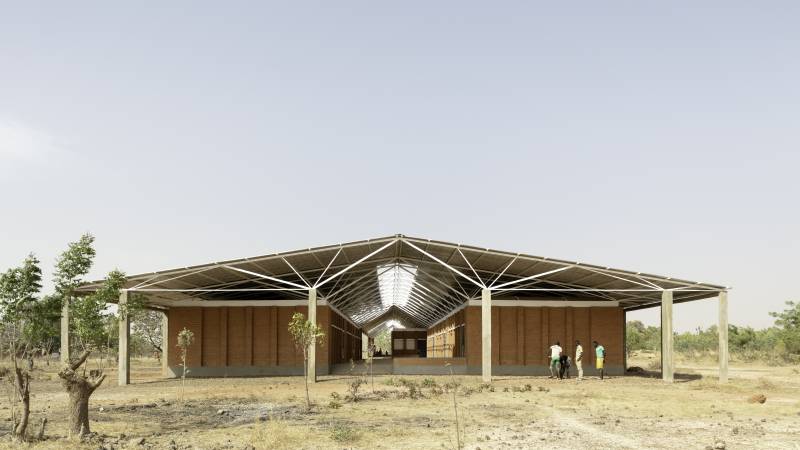
Fig.
2 - Secondary school and service buildings of the Bangre Veenem school
complex, Koudougou, Burkina Faso. Ground floor plan.
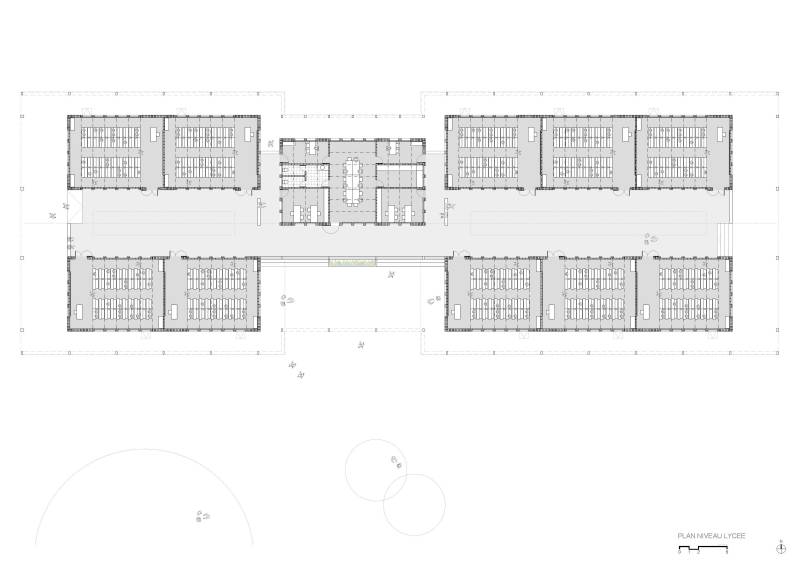
Fig.
3 - Secondary school and service buildings of the Bangre Veenem school
complex, Koudougou, Burkina Faso. Diagram of the metal structure of the
roof.
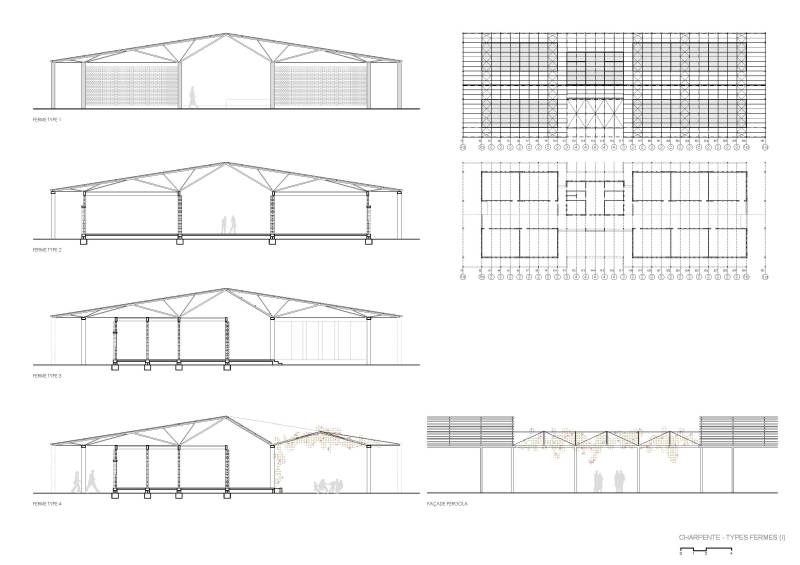
Fig.
4 - Secondary school and service buildings of the Bangre Veenem school
complex, Koudougou, Burkina Faso. The axonometric cross-section shows
the different construction components.
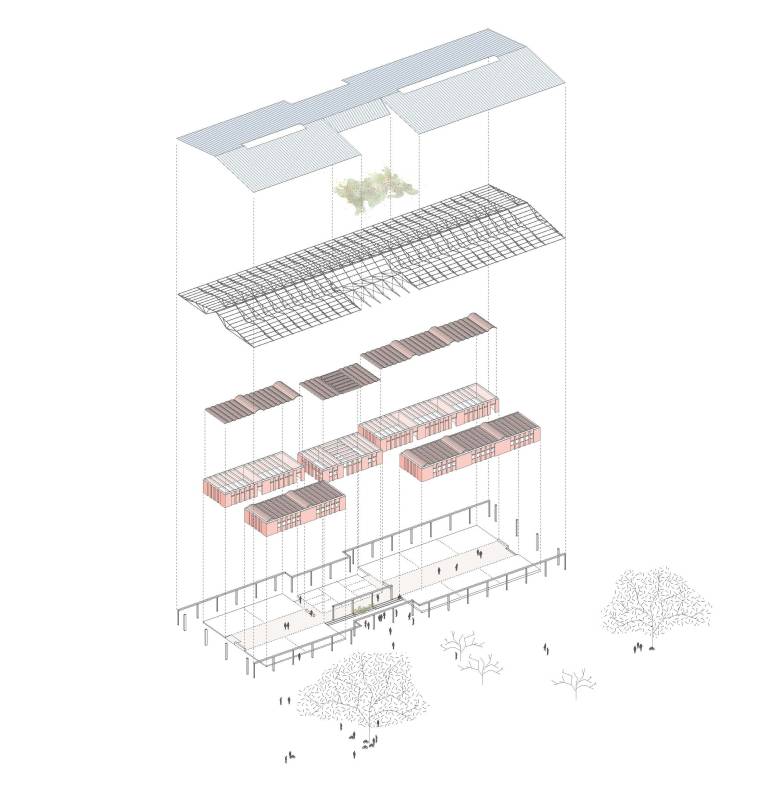
Fig.
5 - Secondary school and service buildings of the Bangre Veenem school
complex, Koudougou, Burkina Faso. Interior view of classrooms.
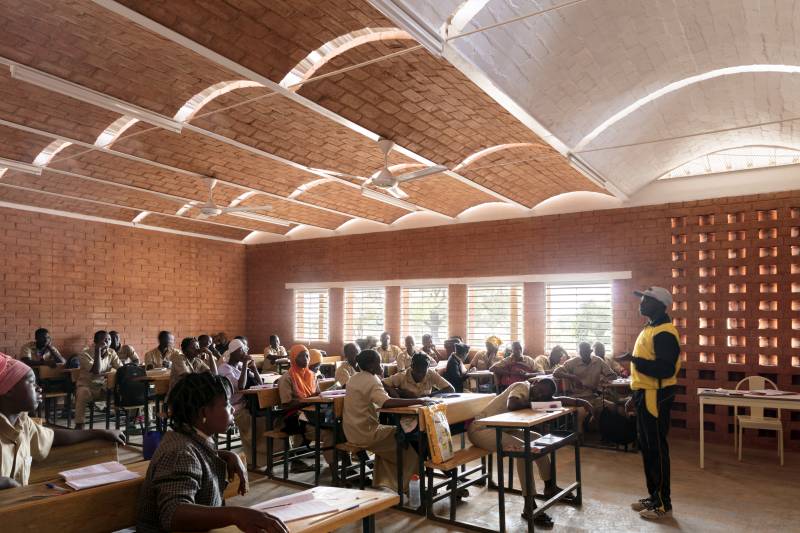
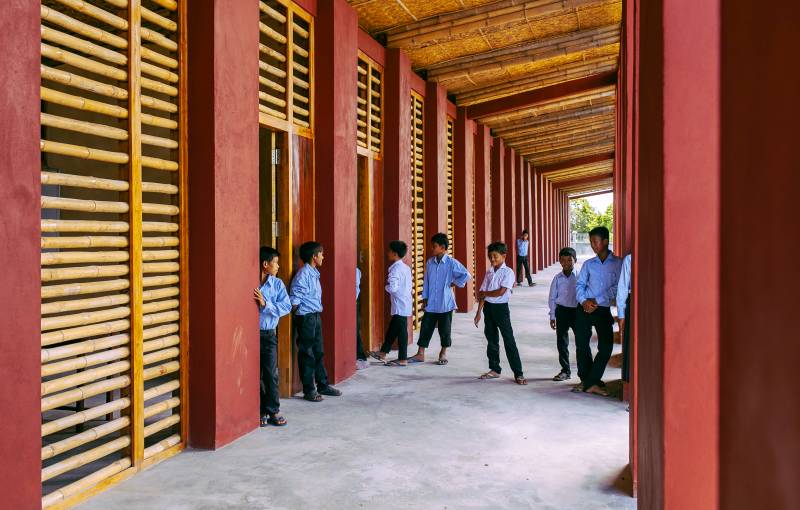
Fig.
6 - Architetti senza Frontiere Italia, Rong Village Secondary School,
Cambodia. View of the internal corridor with the bamboo panels
separating the classroom from the outside.
Fig.
7 - Architetti senza Frontiere Italia, Rong Village Secondary School,
Cambodia. Front view.
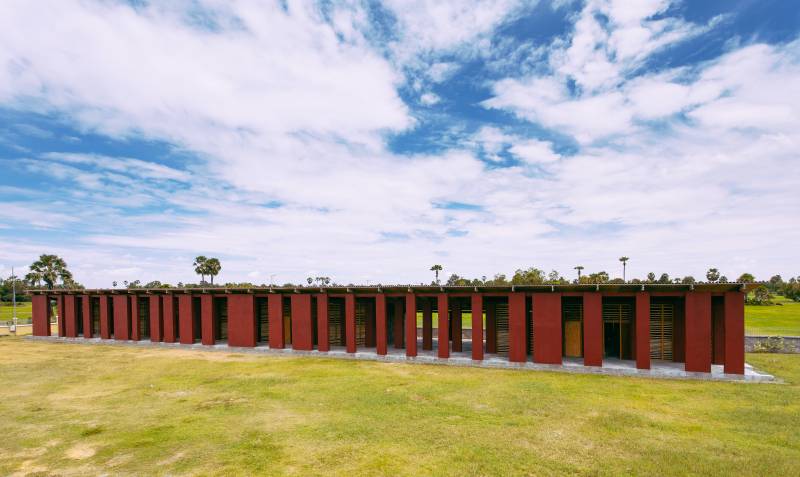
Fig.
8 - Architetti senza Frontiere Italia, Rong Village Secondary School,
Cambodia. Detail of the external façade.
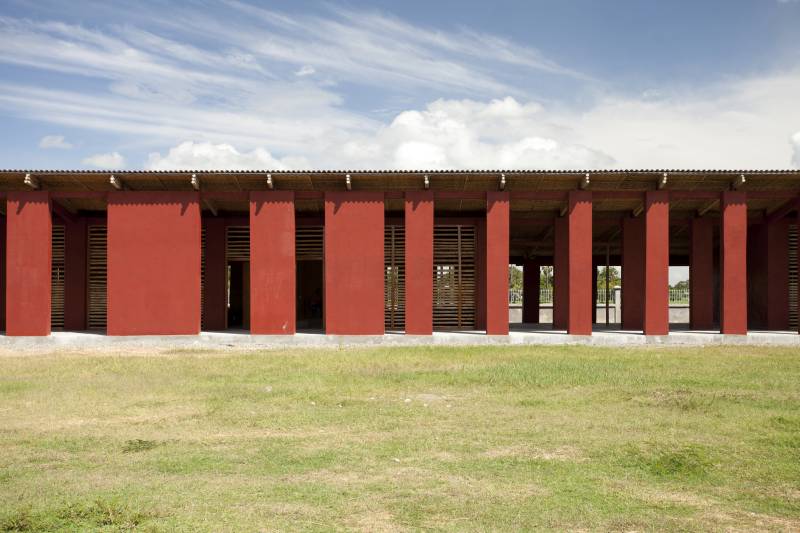
Fig.
9 - Architetti senza Frontiere Italia, Rong Village Secondary School,
Cambodia.
Ground floor plan.
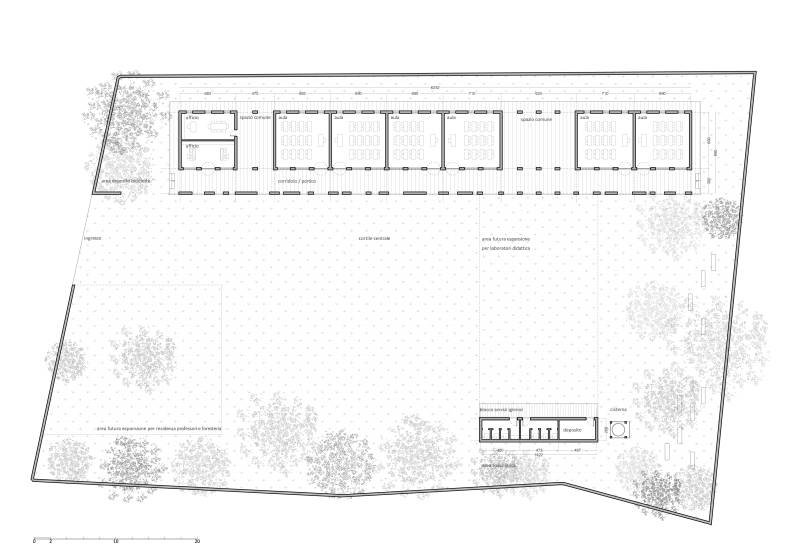
Fig.
10 - Architetti senza Frontiere Italia, Rong Village Secondary School,
Cambodia.
Elevations.
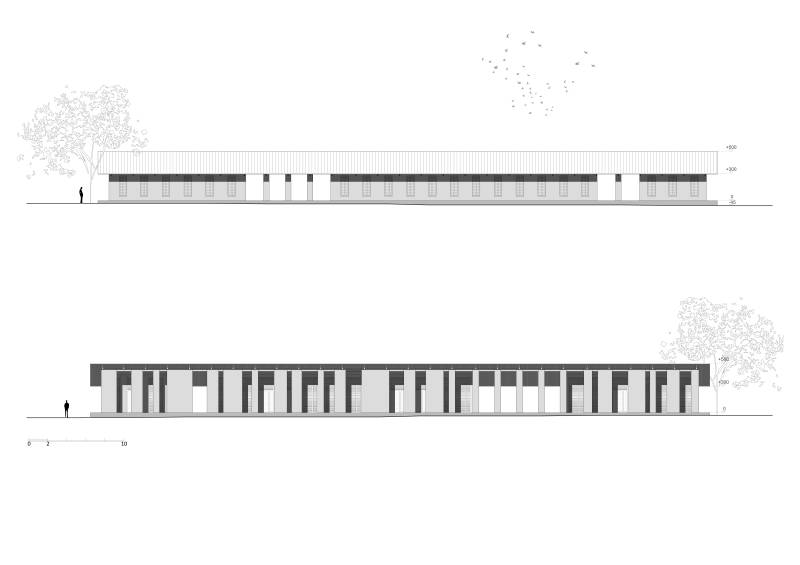
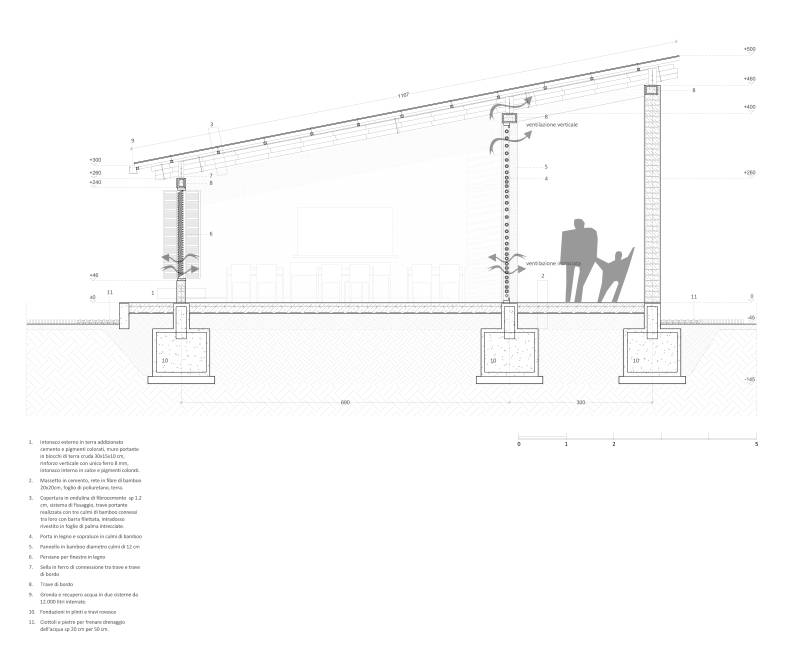
Fig.
11 - Architetti senza Frontiere Italia, Rong Village Secondary School,
Cambodia.
Cross section.
Fig.
12 - Architetti senza Frontiere Italia, secondary school in Rong village, Cambodia.
The construction phases highlight the use of raw earth block and natural plasters.
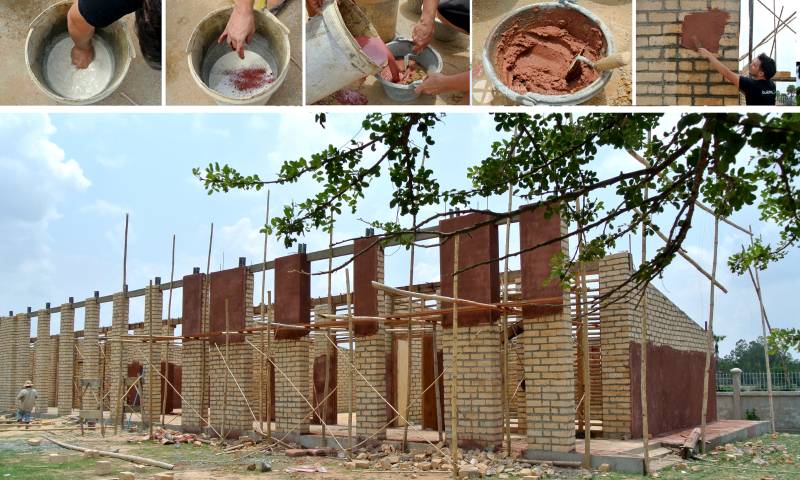
Many people believe that planning in international cooperation
in the context of the “South of the World” (the
Global South) is based solely on humanitarian and social values. This
view is short-sighted and limited. A great effort must be made to
escape the «rhetorical attrition that accompanies the ways in
which these places are described, analysed, experienced and, above all,
communicated by the media. For architects working in the different
countries of the Global South, where it is not easy to know both the
present conditions and the past, traditions and cultures, rhetoric is a
serious danger from every perspective. It is particularly so when
architecture uses it to demonstrate its ability to adhere to the
celebration of the other, turning diversity into a simulacrum, a
rhetorical device»[1]
(AA. VV. 2020).
But if this is the risk, what antidote can be put in place?
Perhaps one way to begin to work on it would be to start studying the
places, processes and contexts in which we operate. The aim would be to
understand the opportunities, recurrences, and most significant design
challenges within a process that is, by its very nature, complicated
and contradictory and which sees architecture as one of the privileged
means of promoting the development of local communities. The goal is to
dissolve the rhetoric in order to learn what the most significant
implications are for those working in the context of the Global South.
At the same time, as architects, the objective is to question ourselves
on the value of architecture in relation to these places, the
consequences of our work, the opportunities and the challenges that
these projects offer to disciplinary reflection.
In the following lines, I will try to focus on a specific type
of building that characterises a large number of projects carried out
in the sphere of International Cooperation: architecture for schools. I
will try to argue the reasons for this choice by highlighting the most
innovative and significant aspects that recent school buildings have
revealed.
Architecture vs. local development
The main objective of any action promoted by International
Cooperation is the development of the beneficiary communities. For this
reason, the first question to be tackled concerns the type of
development that architecture is capable of facilitating. To answer
this question it is necessary to weigh, with witty intellectual
honesty, the differences between promoters and beneficiaries, measure
the relevant economic and social difficulties and consider the
different points of view. When you build a school in an informal or
remote context, what idea of development are you promoting for local
communities?
This issue characterises an open and evolving debate that has
involved international actors and politicians for about seventy years
as well as architects since the 1956 CIAM of Dubrovnick[2] when the
theme of decolonisation and “modernisation” of
African cities became central.
«Think, for example, of Portuguese architects and
their experiences in Angola and Mozambique during the years of
dictatorship between 1926 and 1974, which were prevented to them in
their homeland; or the work of Otto Königsberger who, after
leaving Nazi Germany, studied in Cairo, worked in India and then
directed the Department of Tropical Architecture at the Architectural
Association in London; or people such as Maxwell Fry, Jane Drew and
Ernst May, the designer of the Siedlungen in Frankfurt» (AA.
VV. 2020). Among the many other architects that could be mentioned, it
is particularly interesting to return to the words of Egyptian
architect Hassan Fathy who, in a 1963 letter[3] addressed to Gamal Abdel
Nasser, President of his country, claimed in extraordinarily
contemporary tones the value of architecture as a tool for promoting
community development.
More than half a century has passed since Fathy wrote to
Nasser.
It would be appropriate to keep this in mind when reading his
pages, so bitter in their in dealing with the theme of the 'African
city' and post-colonial development.
«Forgive me, Your Excellency, for leaving my field,
architecture, and entering the field of politics. If I have done so, it
is because development is intimately linked to politics and because it
is my firm belief that the challenges for rural Egypt are identical to
those faced by other parts of the world in Asia and Latin America.
[...] There are currently no cities on our continent that can be called
African in the true sense of the word, whereas there are European
cities located in Africa [...]. Nubian houses and mosques are far more
beautiful and architecturally more harmonious than any residential
complex built by any government or international organisation in the
world [...]. The miserable state of most Egyptian villages is due to
the widespread ignorance and poverty that afflicts the buildings in the
countryside, produced by the feudal system of land ownership, and has
nothing to do with whether the buildings are made of earthen bricks or
reinforced concrete. [...] the decline of traditional building methods,
which made it easy for many people to build their own houses and at the
same time ensured the preservation of ancient artistic values. The
widespread imposition of Western building styles and methods in the
Egyptian countryside, as a prerequisite for development, led to the
extinction of old techniques before new skills took their place. Many
planners and architects consider the fastest possible construction of
towns and villages as a necessary evil. To take this approach to its
logical conclusion, let us imagine that villages and towns could be
prepared overnight and offered to the population. That would be the
worst thing we could do for them: we would be destroying the culture
and civilisation that come from mobilising the local populations'
inventiveness, creativity, and craftsmanship. By building things,
people build a sense of self: forging a citizen with skills and the
ability to build is more important than erecting a building».
These words, seventy years later, strike a chord with the most
adverse problem: how does architecture promote the development of its
inhabitants?
How does a school, in our case, generate growth that involves
not only the students who attend it, but also the inhabitants who live
there?
The relevance of the role of schools: identity
and civic value
Despite the many rhetorical statements, there has been an
undeniable interest in architecture from the “South of the
World” in recent years. This interest is confirmed by a
swirling critical debate on the subject, one of the most significant
moments of which was the 15th Venice Biennale in 2016,
“Reporting from the Front”, curated by Alejandro
Aravena[4].
The reasons for this interest are found in a number of factors,
including: the originality of the solutions adopted; the research
product, in which the culture of the project finds the answers rather
than absolute faith in technology; freedom of expression, where the
design constraints are part of the disciplinary sphere in which we
work, rather than a system of often anachronistic rules; and a way of
searching for meaning in the profession of architectecture which finds
immediate confirmation in these places in terms of social
sustainability. The idea that the projects realised in these contexts
contain aspects of relevance thrives for the entire architectural
community. Among these, the school function plays a leading role,
representing the most important building promoted by international
cooperation. Figures such as Francis Kere[5], for example, have built their
notoriety on the careful production of schools, which, in their various
forms, have explored multiple typological variations.
The reasons for this prominence can be traced back to several
factors. First of all, the financial aspects: both the major
international players and the smaller, independent voluntary
associations see (with farsightedness) educational projects as one of
the primary sectors for promoting local development. This approach has
led to considerable financial resources of various kinds being
channeled into educational projects, which have in turn led, among
other things, to the construction of numerous school buildings. This
growing demand has involved both local and international architects,
encouraging a flourishing disciplinary reflection around this specific
building type. A second reason can be found in the symbolic value of
the school: in many cases, the educational building takes on a
significance that goes beyond its functional purpose. They are located
in poor places where practically everything is missing: roads, water,
electricity, houses, sewers. In other cases they are to be found in
remote areas where the desolation and remoteness from urbanised areas
make any construction particularly complex. In these places, the school
building takes on a remarkable civic value. As well as housing the
teaching activities, the school becomes, by definition, the public
building. It testifies the presence of the state, represents the civic
value of the community and interprets them in one place. It is much
more than an educational building; it is the space in which the
physical, social and economic efforts of its inhabitants are
concentrated. A few examples I draw from experiences in the field and
which I take the liberty of sharing in this scientific paper in order
to evoke the social conditions that characterise these places: the
school is the place where at least one full meal a day is offered,
where people take refuge during tornadoes, where students' uniforms are
always clean, ironed and in good order even in the most desperate
contexts, where teachers sleep on the ground at night because they are
too far from home. It is the place where humanitarian aid is
concentrated; it is the tallest, largest, most visible building, with
the most trees and shade, where pets do not enter and where community
festivals are organised and where, of course, people (occasionally)
vote. From this perspective, the school takes on a symbolic priority
value within the community, the importance of which can be found both
in the functions it performs and in the virtues it evokes.
A third reason is related to identity aspects. As occured, for
example, in nineteenth-century Milan, when the large school complexes,
occupying entire blocks, were able to hinge on the urban plan for the
development of the city drawn up first by Beruto and then by Albertini[6],
contributing to the identity of the new nineteenth-century bourgeois
Milan. So too can the schools in the countries of the South of the
World participate in the construction of a national identity. These are
relatively young nations, the result of colonial legacies that too
often ignored the real boundaries of pre-existing cultures. They are
nations where school architecture contributes to the construction of a
national identity. This is why typological research, settlement
principles, materials, shapes and colours can contribute to defining a
national identity through the systematic organisation of one of its
most representative buildings. A few examples are proof of this: in
recent decades, a fervent proliferation of manuals dedicated to school
construction has characterised the projects of actors such as UNICEF[7] in
collaboration with local governments. This approach reflects a broader
political design aimed at overcoming the repetition of individual local
actions in favour of a more complex vision of identity capable of
incorporating pedagogical reflections, typology, building systems,
settlement principles, use of materials, with the ambition of training
technicians and local offices responsible for governing the process.
A second example concerns the relationship with vernacular
architecture. Many contemporary examples explore successful
reinterpretations of traditional building systems and the use of local
materials. These include the work of Francis Kerè or Albert
Faus in Burkina Faso, the schools of the Caravatti studio in Mali, the
works of Fabrizio Carola in the Sahel, and many others starting with
the already mentioned Hassan Fathy. This sensitivity highlights, among
other things, the successful attempt to build a link with the history
of the people who inhabit these reasons, strengthening the identity
aspects that characterise these places.
The civic value, the social contribution, and the identity
aspects are some of the characteristics that make explicit the
importance of the school building in these contexts. It cannot be
assimilated with other services or buildings; it is the most
representative and prominent building in any village or neighbourhood.
The traditional relationship between signified and signifier goes
beyond any hierarchy, highlighting how the latter (signifier), as well
as the former (signified), is the instrument with which to govern the
settlement and identity processes of these places.
Schools as instruments of innovation
The contexts of the Global South offer, in many ways, a rich
and fertile field of experimentation and new opportunities. The
reduction in regulatory constraints, for example, stimulates renewed
investigation of the relationship between space and function; economic
restrictions are a way of avoiding the most commonplace construction
models in favour of new, more efficient forms; and finally the
encounter between different cultures makes it easier for designers to
listen more closely to local places and cultures.
In these contexts, the design of a school is freed from the
many schematics induced by the various conventions (regulatory,
economic and social) and can go back to investigating, with renewed
creativity, the construction of space as a unique setting for learning.
Natural light, local materials and spatial relations become the
elements with which to organise teaching spaces. The abandonment of all
unnecessary features, all forms of excess and redundancy leads the
project to express itself in its most natural simplicity. In the
strength of this radical simplicity lies the value of this
architecture, which does not limit itself to a Franciscan reduction of
elements, but displays the Paulist sobriety of forms.
Observing the school buildings constructed in the last decade
in the field of international cooperation (ASFItalia, E. Caravatti, E.
Roswag / A. Heringer, Tyin architects, ...) one can see, despite the
heterogeneity of the places and professionals, a common design matrix
capable of combining contemporary languages and vernacular atmospheres.
This approach evokes a postmodern root, emptied of the anti-modernist
ideology that characterised the 1980s. In a somewhat chaotic form,
these projects demonstrate an uninhibited way of drawing on very
distinct formal repertoires, through which different cultures are
brought together as a result of the encounter between beneficiaries and
donors. The positivism that supported the Modern Movement and the
various experiments it carried out in the young nations of the southern
hemisphere between the 1950s and 1970s gives way to the pragmatic
approach of those who aim to solve concrete problems through
architecture and who are not afraid to contaminate the project in order
to embrace all its contradictions.
For these various reasons, observing the design experiences
carried out in these contexts from our perspective, without relegating
them to critical specialisations or regionalisms, allows us to nurture
a disciplinary debate on a specific type of building. It nourishes
fertile reflections that help broaden the theme by recovering the
essence of the problems as they are more evident where the problems are
more urgent and the superstructures less oppressive.
It is with renewed interest, therefore, that we turn away from
all romanticism and the many rhetorics in order to also apply the
rigour of typological and morphological analysis to the contexts of the
Global South with the ambition of discovering new and exciting
architectures.
Notes
[1]
With these words the Casabella editorial staff opened a long article
dedicated to two school buildings by Albert Faus in Burkina Faso and
André Benaim in Ethiopia. Casabella 910, June 2020, 3.
[2]
In 1956, the 10th CIAM congress took place in
Dubrovnik. There, in addition to the famous generational rupture that
gave rise to Team X (both Le Corbusier and Gropius did not participate
in the event, limiting themselves to sending written reflections), new
design attentions spread around the drafting of the “Charter
of Habitat”, associating the idea of the city with those of
“cluster”, “mobility”,
“growth and change”. In particular, the British
MARS group related urban development to social development by adding
the terms 'identity', 'association'. Of the 35 case study panels, some
were devoted to projects in countries in the South.
[3]
The text in question is taken from Salma Samar Damluji and Viola
Bertini's beautiful book, Hassan Fathy. Earth &
Utopia, 2018, Laurence King Pub, London, 2018, 86.
[4]
Alejandro Aravena – starting with the design experience of
Elemental - is the most recognised interpreter of the relationship
between architecture and social projects. Awarded the Prizker Price in
2016 with the curatorship of the XV Venice Biennale
“Reporting from the Front”, he has been able to
consolidate a field of disciplinary reflection in the contemporary
debate.
[5]
Francis Kerè, an architect originally from Burkina Faso,
studied and currently works in Germany. At the beginning of the
millennium, a number of his works in his home country of Gando
attracted a great deal of international interest, also thanks to the
visibility generated by the Aga kahn Award.
[6]
Cesare Beruto, author of the first Milan City Plan in 1884-89 (AA. VV.
(1992) – La Milano del Piano Beruto. 1884-1889,
Società, urbanistica e architettura nella seconda
metà dell'Ottocento. Edizioni Angelo Guerini e
Associati, Milan). The Pavia Masera Plan of 1912 and the Albertini Plan
of 1934 followed the same principles.
[7]
Under the leadership of Unicef headquarters over the past 30 years,
multiple national programmes have been initiated to support the
education policies of various local governments.
Bibliography
AA. VV (1967) – “Africa”.
Edilizia moderna, 89-90.
AA. VV. (2020) – “L’Africa e la retorica
dell’altro. Una pagina di Hassan Fathy”. Casabella,
910,
(June).
B. ALBRECHT (2014) – Africa
big change, big chance. Editore Compositore, Milan.
M. ANTONUCCI, G. NERI (2021) – Pier Luigi Nervi in Africa.
Evoluzione e dissoluzione dello Studio Nervi 1964 – 1980.
Quodlibet Studio, Rome.
C. BOANO (2020) – Progetto
minore. Alla ricerca della minorità nel progetto urbanistico
ed architettonico. LetteraVentidue, Siracusa
C. MAGNI (2016) – Osservare
l’abitare informale. Maggioli, Milan.
S. SAMAR DAMLUJI, V. BERTINI (2018) – Hassan Fathy. Earth &
Utopia. Laurence King Pub, London.











